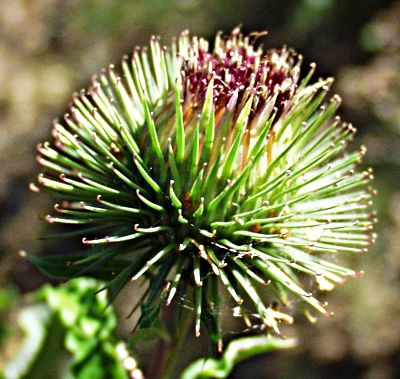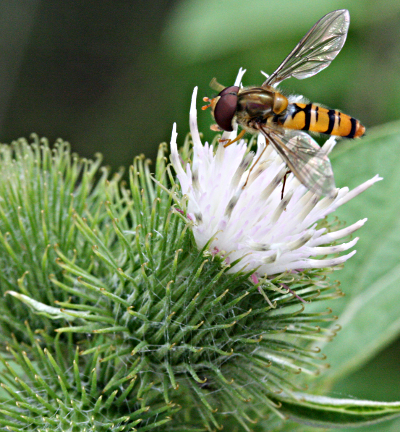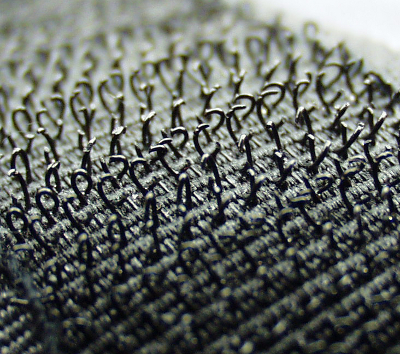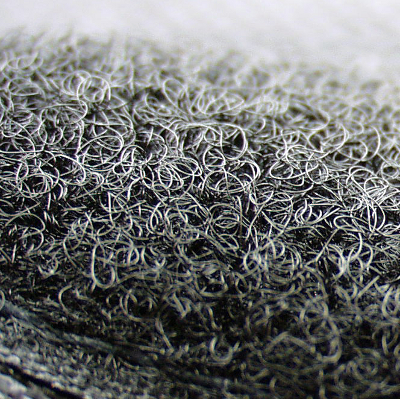Burdocks |

Involucre of the greater burdock

Seldom
burdocks bloom white, but they still attract pollinators,
here
a hoverfly

Hook and loop fastener: hooks

Hook and loop fastener: loops
The infructescences are not completely harmless for humans and animals. During the carefree playing with the burs, the phyllaries may hook to the skin what may cause unpleasant burning sensation. If they get into the eye, it can cause painful inflammations. Dogs often swallow parts of the balls, which often leads to irritation in the throat. For bats burdocks can even be life-threatening if they get caught in it.
The roots of burdock are non-toxic and edible, but have to be harvested before flowering. They taste slightly like artichoke and can be eaten raw, boiled or steamed as a vegetable. The abundant inulin makes the roots, similar to those of the Jerusalem artichoke, suitable for diabetics. In East Asia, there is even a cultivated form of Burdock: Arcium lappa var. edule (Yunnan wild burdock root). Their taproots can reach a length of 1.5 m.
Burdocks as medicinal plants
Mainly the three burdock species listed here, their hybrids and rare other species are cultivated for medicinal purposes. It is primarily the root that are used, which is harvested only in autumn after flowering. A tea made from the root is intended to help against gallstones, liver disease, rheumatism, gout, acne, upset stomach and bladder infection. In addition, it has laxative and diuretic properties. Also on the uterus it has a stimulating effect, so it should not be used during pregnancy.
Applied externally, a tea of burdock root may accelerate the healing of skin problems like acne, pimples, blackheads, tetters, wounds and eczema. The oil from the burdock root is used to treat hair loss.
Historical publications
Dioscorides (1st century AD.) reported in his Materia medica on an Arktion which had leaves like a mullein, a delicate white root and soft stems. Better to burdock fits his description of the Arkeion. It would have pumpkin like leaves, but larger and rougher, and a big root that was white on the inside and black on the outside.
Pliny (about 23–79 AD.) wrote about Lappa, that would attach itself, the flower was not visible, but the seeds would, similar to viviparous animals, develop in a shell. He also mentioned an Arcium, whose description largely coincides with Dioscorides' Arkeion and also would called Persolata.
Hildegard of Bingen (1098–1179) considered the burdock roots useless, the leaves, boiled in wine, however, would help against stones in the body. The flower heads, along with a snail, without the shell, would act pulverized against ulcers on the head.
Leonhart Fuchs (1501–1566) mentioned that the "Groß Klette" (greater burdock) would be called by the Greeks Arcium or Prosopium or in Latin Personatia. The crushing root together with the nuts of the stone pine would help against pain in the joints and those who eject blood and pus. The leaves crushed with salt and placed onto the body would help against animal bites. Together with egg white they would heal burns.
The hook and loop fastener
The Swiss engineer Georges de Mestral (1907–1990) developed a locking system, which he copied from the burdock. It consists of two different tapes. One has a lot of small hooks on the surface, the other one a large number of small loops. If the tapes are pressed together, the structures caught in each other, similar to the phyllaries of burdock in hair or textiles.